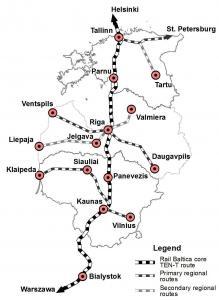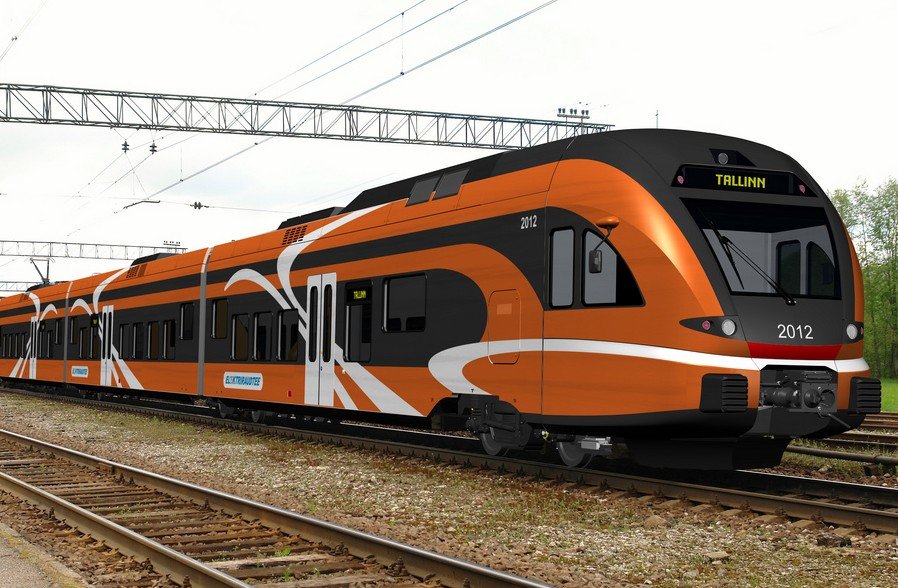Rail Baltic to connect the capitals of Estonia, Latvia and Lithuania with a high-speed railroad.
The original report was first written by Frances Robinson and Liis Kängsepp for The Wall Street Journal, and has been republished by kind permission. Additional reporting by Estonian World.
There’s a point on the border between Latvia and Estonia where picturesque little villages are used to the sight of freight trains rumbling by. But last month they got to see something different.
Emblazoned with the European Commission logo and “RB Express”, a passenger train carrying dozens of VIPs, journalists, civil servants and railway experts was trundling along the route to promote the European Union’s grand plans for transport. One of those projects is Rail Baltic, which will connect the capitals of Estonia, Latvia and Lithuania with a high-speed railroad.

“Nobody in the Baltics takes the train these days – it is just inconvenient and very time-consuming,” Indrek Sirp, the chairman of the Rail Baltic task force, explained. People tend to drive or fly. In the future, however, it should take two hours to get from Tallinn to Riga (at the moment with a bus it takes four) and four hours from Tallinn to the Lithuanian-Polish border (at the moment it’s a 10-hour drive).
Quite what the new trains are going to look like will depend on how the industry will evolve over the next 10 to 12 years. They will certainly be more comfortable and speedier than the long-distance trains currently operating in the Baltics.
“There will of course be very comfortable seats, good catering and excellent facilities for working, and of course wireless internet,” Sirp said, noting there actually was a train connection between Tallinn and Warsaw at one point in the 1990s – but it was uncomfortable and unprofitable, so it didn’t last.
To provide an idea of what to expect, Lithuanian Railways put together a five-car train involving two passenger cars, two dining cars and a conference car. This VIP vehicle had a boardroom, space for a temporary television studio and a sleeping compartment, and only gets four or five outings a year, so it’s pretty special.
Still, there was certain theatricality to the proceedings. For starters, “Express” is a generous description for the train that was frequently overtaken by cars on the highway alongside. At each border, the whole enterprise had to stop while locomotives were switched – with Lithuania starting off with a Siemens locomotive usually used for freight and Latvia changing to an old Soviet-built behemoth. Passengers were greeted by choirs, mayors were showing off their 19th-century Russian railway architecture and presenting local cake.
When the new line is finished, the trains will be going much faster – up to 240 kilometers (150 miles) per hour.
But will people actually take advantage of this opportunity? Sirp said he believed they will. An analysis made in 2011 predicts there will be around 3,000 people traveling back and forth between Tallinn and Pärnu – the first stop on the railroad after Tallinn – every day.
And even though last month’s trial service was only a special charter, according to Martynas Tarvidas from Lithuanian Railways’ passenger-trains unit, “It’s a huge thing, to finally get a single train going from Vilnius to Tallinn. It’s a piece of history.”
Rail Baltic
Rail Baltic is one of the priority transport projects of the European Union. The project is supposed to link Finland, the Baltic States and Poland and also improve the connection between Central and Northern Europe and Germany. It envisages a continuous rail link from Tallinn (Estonia), to Warsaw (Poland), going via Riga (Latvia) and Kaunas (Lithuania). It will by-pass the Kaliningrad Oblast (Russia) and Hrodno (Belarus) where the two historic rail routes Poland-Lithuania have been going.
The section from Helsinki to Tallinn will be operated by existing commercial ferries. In the future a proposed Helsinki to Tallinn Tunnel could provide a rail link between the two cities.
I
Cover photo courtesy of Wikimedia Commons.

